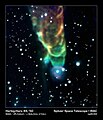Dosya:Herbig-Haro 49 50.jpg

Tam çözünürlük ((2.700 × 3.150 piksel, dosya boyutu: 1,71 MB, MIME tipi: image/jpeg))
Bu dosya Wikimedia Commons'ta bulunmaktadır. Dosyanın açıklaması aşağıda gösterilmiştir. Commons, serbest/özgür telifli medya dosyalarının bulundurulduğu depodur. Siz de yardım edebilirsiniz. |
Özet
| AçıklamaHerbig-Haro 49 50.jpg |
English: This "tornado," designated Herbig-Haro 49/50, is shaped by a cosmic jet packing a powerful punch as it plows through clouds of interstellar gas and dust.
The tornado-like feature is actually a shock front created by a jet of material flowing downward through the field of view. A still-forming star located off the upper edge of the image generates this outflow. The jet slams into neighboring dust clouds at a speed of more than 100 miles per second, heating the dust to incandescence and causing it to glow with infrared light detectable by Spitzer. The triangular shape results from the wake created by the jet's motion, similar to the wake behind a speeding boat. The scientists could only speculate about the source of the spiral appearance. Magnetic fields throughout the region might have shaped the object. Alternatively, the shock might have developed instabilities as it plowed into surrounding material, creating eddies that give the "tornado" its distinctive appearance. Astronomers believe that the blue color at the tornado's tip results from high molecular excitation at the head of the shock. Those high excitation levels generate more short-wavelength emission, shown as blue in this color-coded image. Molecular excitation levels decrease away from the head of the bow shock; therefore the emission is at longer wavelengths, colored red here. The star at the tip of the tornado, which appears to be surrounded by a faint halo, might be a chance superposition along our line of sight. However, the star instead might be physically associated with the tornado. In that case, the halo likely is due to the outflow running into circumstellar material. HH 49/50 is located in the Chamaeleon I star-forming complex, a region containing more than 100 young stars. Most of the new stars are smaller than the sun, although some are more massive. Visible-light observations have found a number of outflows in the region, however most of those outflows have no infrared counterpart. |
| Tarih | |
| Kaynak | http://www.spitzer.caltech.edu/images/2311-sig06-002-Cosmic-Tornado |
| Yazar | NASA/JPL-Caltech/J. Bally (University of Colorado) |
Image use policy: http://www.spitzer.caltech.edu/info/18-Image-Use-Policy
Lisanslama
| Public domainPublic domainfalsefalse |
| Bu dosya NASA tarafından üretildiği için kamu malıdır. Aksi belirtilmediği sürece "NASA tarafından üretilen malzemenin telif hakkı olmadığı" NASA telif politikasında belirtilmiştir. (Bkz. Template:PD-USGov, NASA copyright policy page veya JPL Image Use Policy.) |  | |
 |
Uyarılar:
|
Altyazılar
Bu dosyada gösterilen öğeler
betimlenen
12 Ocak 2006
Dosya geçmişi
Dosyanın herhangi bir zamandaki hâli için ilgili tarih/saat kısmına tıklayın.
| Tarih/Saat | Küçük resim | Boyutlar | Kullanıcı | Yorum | |
|---|---|---|---|---|---|
| güncel | 17.06, 20 Haziran 2011 |  | 2.700 × 3.150 (1,71 MB) | Spitzersteph |
Dosya kullanımı
Bu görüntü dosyasına bağlantısı olan sayfalar:
Küresel dosya kullanımı
Aşağıdaki diğer vikiler bu dosyayı kullanır:
- ar.wikipedia.org üzerinde kullanımı
- ca.wikipedia.org üzerinde kullanımı
- en.wikipedia.org üzerinde kullanımı
- mk.wikipedia.org üzerinde kullanımı
Meta veri
Bu dosyada, muhtemelen fotoğraf makinesi ya da tarayıcı tarafından eklenmiş ek bilgiler mevcuttur. Eğer dosyada sonradan değişiklik yapıldıysa, bazı bilgiler yeni değişikliğe göre eski kalmış olabilir.
| Resim başlığı | This "tornado," designated Herbig-Haro 49/50, is shaped by a cosmic jet packing a powerful punch as it plows through clouds of interstellar gas and dust.
The tornado-like feature is actually a shock front created by a jet of material flowing downward through the field of view. A still-forming star located off the upper edge of the image generates this outflow. The jet slams into neighboring dust clouds at a speed of more than 100 miles per second, heating the dust to incandescence and causing it to glow with infrared light detectable by Spitzer. The triangular shape results from the wake created by the jet's motion, similar to the wake behind a speeding boat. The scientists could only speculate about the source of the spiral appearance. Magnetic fields throughout the region might have shaped the object. Alternatively, the shock might have developed instabilities as it plowed into surrounding material, creating eddies that give the "tornado" its distinctive appearance. Astronomers believe that the blue color at the tornado's tip results from high molecular excitation at the head of the shock. Those high excitation levels generate more short-wavelength emission, shown as blue in this color-coded image. Molecular excitation levels decrease away from the head of the bow shock; therefore the emission is at longer wavelengths, colored red here. The star at the tip of the tornado, which appears to be surrounded by a faint halo, might be a chance superposition along our line of sight. However, the star instead might be physically associated with the tornado. In that case, the halo likely is due to the outflow running into circumstellar material. HH 49/50 is located in the Chamaeleon I star-forming complex, a region containing more than 100 young stars. Most of the new stars are smaller than the sun, although some are more massive. Visible-light observations have found a number of outflows in the region, however most of those outflows have no infrared counterpart. |
|---|---|
| Yazar | Spitzer Space Telescope |
| Telif hakkı sahibi | http://www.spitzer.caltech.edu/Media/mediaimages/copyright.shtml |
| Genişlik | 2.700 px |
| Yükseklik | 3.150 px |
| Sıkıştırma şeması | LZW |
| Piksel bileşimi | RGB |
| Yönlendirme | Normal |
| Bileşen sayısı | 3 |
| Yatay çözünürlük | 300 dpi |
| Dikey çözünürlük | 300 dpi |
| Veri düzeni | tıknaz biçimi |
| Kullanılan yazılım | Adobe Photoshop CS3 Macintosh |
| Dosya değişiklik tarihi ve zamanı | 14.33, 5 Haziran 2009 |
| Renk aralığı | Kalibrasyonsuz |